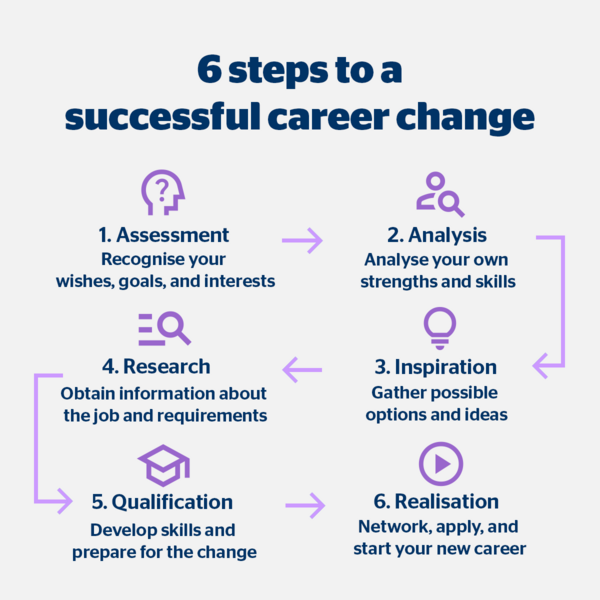Career change: Starting a new path step by step
|

reading time: ca. 6 minutes
- If you are no longer satisfied in your current job or looking for a new purpose, you can consider a career change or a lateral entry. There may also be changes in the labour market or health reasons that make a reorientation necessary.
- A career reorientation should be well considered and planned. It helps to be clear about your own wishes and strengths beforehand and to explore various options for a new direction in your career.
- Some career changes require professional development or retraining. In many cases, however, it is enough to simply brush up on certain skills. And sometimes a lateral entry is even possible without any qualifications at all.
- Many skills can be transferred to a new professional field or industry. Despite initial doubts, it is important to take a chance on a career change and keep your own goals in mind.
Whether it's due to external changes, job dissatisfaction, or the desire for further development – there are many reasons for a career change. If your work feels more like a duty than a pleasure, it makes sense to think about new career paths. After all, it's never too late to start over.
More and more people are feeling the need for change. There are many reasons for this, both external circumstances and inner drives and desires. The shift in values in the working world has changed the way people look at their job: It's no longer just about earning money, but also about satisfaction, health, and genuine fulfilment. If this is lacking, a professional reorientation can be the right move.
What does a career change mean?
Career change means making a conscious decision in favour of a new career path that better suits your current interests, values, or life goals. This is not just about a change of scenery, but about a long-term strategic reorientation.
When does a career change make sense?
There are many reasons for a career change. Thorough self-reflection helps you decide whether the change makes sense. A reorientation does not only bring opportunities but also challenges.
Typical reasons for a career change
- Quitting or losing your job
- Changes on the labour market or in the industry
- Dissatisfaction in your current job
- Change of your own values or interests
- Desire for self-realisation or more purpose
- Better balance between work and family life
- Stress, burnout or health problems
Career reorientation – yes or no?
The idea of reorienting yourself professionally does not arise overnight. Rather, it is a long-term process, and the decision is not always easy. If you have not felt comfortable in your job for quite a while, you should ask yourself the following questions:
- How satisfied am I with my current job?
- Can I really utilise my skills and strengths?
- What motivates me, and does this apply to my current job?
- What values are important to me and am I living them in my current work environment?
- Do I have internal development opportunities?
- What would have to change for me to enjoy my current job again?
- If I could turn back time, would I choose this profession again?
- What would I do if money was no issue?
- Are there any professional dreams that I have not yet fulfilled?
- What fears or worries are preventing me from making a change?

Thorough self-reflection is important in order to find out whether a reorientation makes sense. The step into a new job must be carefully considered, and a completely new start is not always the best solution. Sometimes a smaller change is enough, for example a new position in the same company or a new employer.
A career change offers many opportunities, but also brings challenges.
A clear roadmap helps to systematically approach the new start. This allows you to plan and implement your new career path step by step:
- Assessment
- Analysis
- Inspiration
- Research
- Qualification
- Realisation
A good plan provides clarity, orientation, and security. This turns a vague desire for change into a concrete process with a common thread.

Step 1: Assessment of your own wishes
Every career reorientation starts with an honest review: What do you want from your new job? Is it more purpose, more flexibility, a better salary, or new challenges?
Take some time to reflect on your interests and goals. Write down what is important to you in your job and what things you don't want any more. This is the foundation for all further steps.
Step 2: Analysis of your strengths and competences
What strengths, experiences, and skills have you gained in your previous career? Note down both professional and social skills and consider which of these would help you in other professional fields.
Soft skills such as leadership, teamwork, and communication abilities are particularly valuable. Technical expertise or experience in project management can also be easily transferred to other jobs and industries.
Step 3: Inspiration and collection of options
The next step is to gather concrete options. Which professions, sectors, or tasks match your strengths and wishes? Collect ideas and get inspiration from job portals, career blogs, or career counselling, for example.
You may discover opportunities that you have never thought of before. Talking to people who have already taken similar steps can also be helpful.
Step 4: Research and obtaining information
As soon as you have a few promising options, it's time to do some research. Gather information about your new favourite job, for example about requirements, tasks, or typical work processes.
Perhaps you have contacts in your network who work in this profession or industry? Talk to people in the field or search online for testimonials. If you want to be on the safe side, look around for internship opportunities. This will give you an even better idea of whether the direction really suits you.
Step 5: Qualification and preparation for the change
Depending on the desired job, professional development or retraining may be necessary. Sometimes it is also sufficient to learn or refresh individual skills, for example in using certain tools. Research which online courses, certificates, or part-time training programmes will help you.
Digital networking via platforms such as LinkedIn and revising your own application documents is also good preparation.
Step 6: Realisation of the restart and application
Once everything is prepared, you can get started. Apply for suitable jobs and don't be discouraged by initial rejections. Use your personal network to get in touch with contacts or find vacancies. Now may also be the right time to take the plunge into self-employment or start your own business.
The important thing is to remain flexible, open to opportunities, and have confidence in your goals. If you have considered your decision carefully beforehand, a new start is not a leap into the unknown, but a well thought-out and courageous step into a new professional future.
Success stories and tips for a career change
A recent study by the Stepstone Group from 2025 shows that a new career start is no longer uncommon. Almost half of those surveyed had already made a career change at that time. And the great thing is: three out of four career changers have been happy in their job since their reorientation.
But how does such a reorientation succeed in practice? We spoke to people at OVB who have taken a rather unusual career path.
The right moment is now
Changes in the modern working world are opening up new opportunities. The doors for lateral entry and professional reorientation have never been as wide open as they are today. The shortage of skilled labour, digital transformation, and changing values in society are causing companies to increasingly look for motivated individuals with a fresh perspective and diverse experience – and not just straightforward CVs.
Actively shaping your professional future requires courage, but also confidence in your own abilities. There are many ways to start your new career. Those who prepare themselves well and keep their own goals in mind have the best chance to successfully reorient themselves today – towards a career that truly fulfils them.






